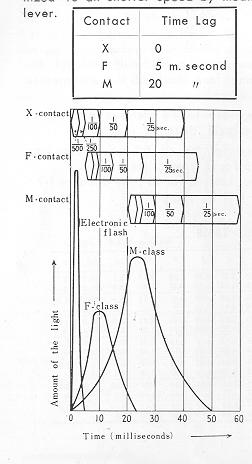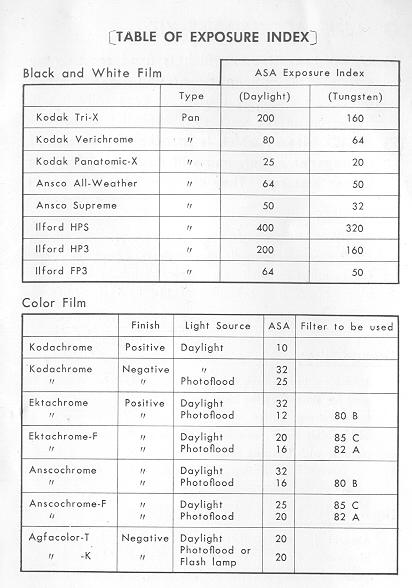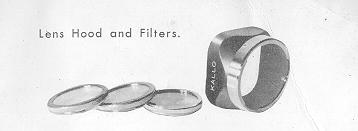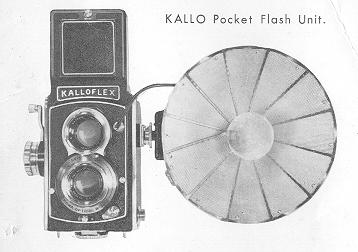Kowa KALLOFLEX
Posted 7-12-'03
This camera manual library is for reference
and historical
purposes, all rights reserved.
This page is copyright
© by

,
M. Butkus, NJ.
This page may not be sold or distributed without
the expressed
permission of the producer.
I have no connection with any camera company.
On-line camera manual library
Back to main on-line manual page
If you find this manual useful,
how about a donation of
$3 to:
M. Butkus, 29 Lake Ave.,
High Bridge, NJ 08829-1701
and send your e-mail address
so I can thank you.
Most other places would charge
you $7.50 for
a electronic copy
or $18.00 for a hard to read Xerox copy.
This will help me to continue to host this site,
buy new manuals, and pay their shipping costs.
It'll make you feel better, won't it ?
If you use Pay Pal, use the link below.
Use the above address
for a check, M.O. or cash.
Problems opening
PDF files or printing problems
- click here
Click here for Kowa KALLOFLEX
PDF version
- Better Printing -

 |
1. Hood lifting button.
2. Exposure counter.
3. Film advance and shutter tensioning crank.
4. Depth of field scale.
5. Focusing knob.
6. Film indicator.
7. Distance scale.
8. Lever for shutter speed control.
9. Synchro M-X lever.
10. Direct view finder panel. 11. Indication window for shutter and diaphragm lever. |
 |
12. Flash cable socket.
13. Lever for diaphragm control.
14. Shutter release button.
15. Shutter release guard.
16. Tripod socket. Back lock.
17. Winding key for take-up spool.
18. Eyelet slot for neck strap.
19. Take-up spool knob.
20. Red mark for loading film.
21. Accessory clip.
22. Film spool knob.
23. Film pressure plate.
24. Anti-reflection baffle. |
KALLOFLEX INSTRUCTIONS MANUAL FOR PRACTICAL USE
 |
Your KALLO FLEX CAMERA is a
precision-engineered instrument that will give you many years of plea sure.
You will find that your KALLO FLEX is faster to operate (a single lever
stroke advances and counts your film, winds and winds the shutter), easier
to operate (all your settings are viewed from the top,,, you never have to
remove the camera from its shooting position.
Your KALLO FLEX CAMERA contains the finest optical system... highly color
corrected, 4-element, 75 mm f 3.5 Taking-Lens with an amazing resolving
power of 125 Lines per millimeter wide open.
The exclusive, KALLO FLEX convex ground glass makes your picture simpler
and surer.., the focusing screen actually gives you up, to 50% brighter
center image and 5 times brighter image at the edges. |
A. FILM LOADING
|

|
 |
1) The Kallo flex takes 120 roll film and will give 12 2 1/4" X 2 1/4" pictures.
To open the back, turn tripod socket back lock (16) which is located at
'the bottom of the camera toward the " O " position. This will move the
latch forward and open the back of ' the camera. |
 |

|
2) To insert the empty spool Fit an
empty spool over the winding key (17) on the right or crank side. Pull out
the guide knob (19) and push the spool down into position), Snap the guide
knob to closed position. 3) Insert a roll of film at (22) in the same way
as applied to the take-up spool. Break the seal on the film and pull out the
beginning of the paper leader. Put the beginning of the leader through the
long slot of the take-up spool. The film is now properly attached.
4) Advance the crank (3) in an clockwise direction (forward) until
the two marks on the paper leader line up with the red dots on the back of
the camera (20). Once these marks are correctly positioned, close the camera
back and lock it by turning the back lock (16) to the C position. Turn the
crank (3) forward until it stops. You will notice that the exposure counter
(2) now indicates that you are ready to take the first picture. The shutter
is already set.
|
B. Taking the picture
 |
1) Remove the lens cap by lifting it away from the bottom lens with
your finger nail and then turn counter clock wise about a quarter turn to
release the upper part from the upper lens bayonet.
2) Erect the focusing hood by moving button (1) in the direction of the arrow. |
3) Raise the magnifier to assist critical focusing by use of the
finger nail. To close the magnifier, push it down until it snaps into position.
Do not touch the lens itself in these operations since it is difficult to focus
the camera if the magnifier lens is dirty. Always clean loses with optical lens
tissue.
4) To use the Direct view sports finder at eye level, push in panel (10)
until it snaps into place. Be sure to raise the magnifier before you attempt to
push in panel. To close the sports finder, press the back release located behind
the viewing hood to your right.
 |
5) To focus the camera, turn the focusing knob (5) forward or
backward. You will observe that the image becomes sharp and unsharp as you do
this. When image appears sharpest on the ground glass, the camera is in focus.
The magnifier enables you to get the sharpest possible focus. Since the
two lenses operate together, the taking lens is properly focused when the ground
glass image is sharp. The Kallo flex camera incorporate an exclusive focusing
design in its ground glass. |
The glass has a convex slope that permits the photographer to view his
subjects without bending over the camera or tilting it. This convex glass
also provides a brighter picture area.
6) Center your subject in ground glass, using hairlines on the ground
glass to center and compose your picture. What you see on the ground glass will
be on the film. Hairlines will enable you to compose your picture either for
horizontal or vertical format in enlarging.
Center square made by hairlines also makes it possible for you to compose the picture for 2,X 2" slide.
Inexpensive paper mounts for 2" X 2" slide from 120 Roll film can be obtained at any photographic store.
7) The Kalloflex does not require any mechanical compensation for
Parallax adjustment. The slope of the Ground Glass and the design of the viewing
system eliminate the possibility of cutting off heads in closeups of people.
This is accomplished by our taking off a very small area from the part of the
Ground Glass where this difficulty would ordinarily occur.
 |
8) Setting the Diaphragm - The
maximum lens opening of the picture taking lens on this camera is F3.5. This
is a measure of the ratio of the diameter of the lens to the focal length of
the lens. It is a measure of the amount of light that can pass through the
lens. The lens openings can also be set to F 4, 5.6, 8, 11, 16, 22 each
setting closes down the lens opening by about half the amount. F/11 permits
half the light allowed by F8 to pass through the lens. The diaphragm lever
(13) sets the lens openings. You will notice that there is a click stop for
each setting, permitting you to change lens settings in dim light or without
looking at the window (11) where the setting is shown. |
9) Setting the Shutter Speeds - The Seikosha MFX shutter permits a full range of shutter - speeds to be used. It also has click stops that will show the
setting in the window (11).
The shutter speeds are B. 1, 2, 5, 10, 25, 50, 100, 250 and 500. To change from one speed to another, move lever (8).
 |
10) To snap the picture, hold the
camera so that it sits snugly in the palm of your left hand with your left
forefinger or thumb over the Shutter Release Button (14). Using your right
hand to turn your Focusing Knob (5) you're ready to take your picture
instantly. Merely press gently on the shutter release button. If the button
does not depress, check to see whether the shutter release guard (15) has
been set to prevent accidental exposures. Move it to the other side in that
case. If the film has not been wound, then the shutter is not set and the
picture cannot be taken until the film is wound by moving crank (3) forward
until it stops and then back until it stops.
|
| Summary of operating procedures |
1. Set the lens opening and shutter speeds for the proper exposure
2. Focus the camera
3. Take the picture
4.- Wind the film, setting the shutter
 |
If the film has been wound, the shutter can be released, If the shutter
cannot be released, the film has not been advanced. When winding the shutter and
advancing the film the operation is a motion forward of crank (3) until it stops
and then a motion back again until it stops. With each exposure, the amount of
crank travel decreases gradually to about half a turn.
After the 12th and last exposure, several complete forward turns will wind
off the paper backing of the film and the number "O", will appear in the
exposure counter window. |
C. Setting the Aperture & Shutter Speed
1) The correct exposure is achieved by the proper setting of the lens
opening (diaphragm) and the shutter speeds. A good basic exposure to use in
outdoor pictures in sunlight is at 1/50 second. The use of an exposure meter or
following the instructions that come with your film will be helpful in getting
properly exposed negatives. If the light is less bright, as on the shaded side
of a street, open the lens one stop to F8 leaving the shutter at 1/50 second. If
the light is brighter than average, as at the beach or in the mountains or on
the water, close down the lens one stop to F 16 with the shutter left at 1/50
second.
In very dim light, pictures can be obtained with the new fast films at f3.5 and 1/50 second. An exposure meter is needed for such dim light conditions.
2) Shutter speeds of 1/100, 1/250 and 1/500 are used to stop fast action
if pictures are taken of fast moving objects or sporting events. Since the
amount of light is cut clown by faster shutter speeds, the lens opening has to
be opened to obtain equivalent exposures.
Shutter speeds can be changed even after the film has been wound and the shutter set.
The exception to this is the speed of 1/500 second. You cannot move to this speed after the shutter has been wound.
|
Diaphragm |
3.5 |
4 |
5.6 |
8 |
11 |
16 |
22 |
| Exposure |
3/8 |
1/2 |
1 |
2 |
4 |
8 |
16 |
 |
3) The Kallo flex camera can be used
with a Leica type cable release which fits over the shutter release button
(14). To take a time exposure, set the shutter to B (Bulb) which causes the
shutter to remain open as long as pressure is maintained on the shutter
release, press the shutter release and swing the safeguard release to locked
position. To close the shutter, swing the release guard down to the inside
position.
|
 |
4) Intentional double exposures are possible. To reset the shutter without advancing the film, push down the
release button at the back of Focusing knob and turn the crank counterclockwise (backward) one full turn.
|
 |
5) To take your own picture, attach a separate Self-Timer to the shutter release, using a Leica type adapter. The
model with the curved stem will not get in the way of the lens.
The Self Timer lets you get into the picture even if taken by flash or strobe lighting.
|
 |
6) To remove the front hood of case hold
camera in a picture-taking position, with hood open. Grasping hood near the Metal hinge, pull to the left so that the hinge disengages. To replace hood,
engage hinge at the right side, pull toward the left so that you can engage left side of hinge. (see illustration) |

D. Depth of Field Scale
 |
The purpose of a diaphragm is not only
to adjust the amount of light that passes through the lens but also to
control the depth of field. When a certain point is focused upon, a certain
area before that point and behind that point will also be in sharp focus.
The zone of sharp focus depends upon the distance from the point focused
upon and the F stop used for the exposure. The smaller the F stop the
greater the depth of field. The further the distance focused upon the
greater depth of field. The 2 diaphragm scales above the focusing knob
indicate the extent of the depth of field for any focused distance or
desired stop.
|

 |
Hyper focal Distance When your camera is set for infinity, what the nearest distance that is sharp ? Hyperfocal distance for this camera is as follows:
| F 3.5 |
108.7' |
| F 4 |
101.3' |
| F 5.6 |
71.8' |
| F 8 |
50.4' |
| F 11 |
36.8' |
| F 16 |
25.3' |
| F 22 |
18.5' |
|
If you focus your camera on the Hyper focal distance, everything from half of the distance to infinity will be sharp.
For example, we are taking pictures outdoors at F 8. The Hyperfocal distance is 50'. Set your camera for 50' at F 8, now everything will be in sharp focus
from 25' to infinity. At F 16, set your camera for 25', the distance from 12' to infinity will be sharp.
E. FLASH PHOTOGRAPHY
In modern flash photography the camera shutter takes over the task of firing the
bulb electrically at the right moment. The Seikosha-MX shutter in the KALLOFLEX
is for this purpose, equipped with MFX contacts. This enables adjustment to the
required delay of the flash lamps should be synchronized to all shutter speeds
by means of changing lever.

1. X- Contact
This is used for an electronic or strobe flash unit with zero delay. The flash
goes off as soon as the shutter blades reach full opening.
Since the duration of the flash itself is actually shorter than and shutter setting, any shutter speed may be selected, but it is advisable to use a speed of 1/100 second.
2. F-Contact
This is applicable to F-Class bulb, and is made approximately 5 milliseconds, before the shutter blades are fully opened.
F-Class bulb is comparatively low in its illumination power so it is most suitable to use in ordinary room or in your home at about 15 feet.
3. M-Contact
This is applicable to M-Class bulb which has a considerably higher
power illumination and a long light duration as illustrated. The contact is made
approximately 20 milk-seconds before the shutter blades reach full opening.
The intensity of flash illumination decreases according to the
square of the distance, therefore the distance from flash to subject must be
carefully measured in selecting diaphragm opening.
Lamp manufacturers will supply guide numbers to use which are
divided by the distance in feet to get the required diaphragm opening.
The last but not least. Never forget to attach a lens hood in flash photography.
F. TO USE FILM REMINDER DIAL ON FOCUSING KNOB
Center scale indicates type of film you cite using, and is adjusted by turning
protruding pins on dial face. To set the proper ASA film speed on the outer
dial, press knurled rim down, by pushing at opposite edges of the rim, which
turning to the film speed desired.
 |
The film speed in ASA shown in numbers
on the disk, 8, 10, 12, 16, 25, 32, 40, 50, 100, 160, 200, and 400. While
the type of film is classified in Ortho, Pan, D. Col, T Col, and I.R.
D. Col. - Daylight color film.
T. Col. - Tungsten color film.
I. R. - Infrared film. |
COMPARISON TABLE OF FILM SPEEDS
| ASA |
8 |
10 |
12 |
16 |
25 |
32 |
40 |
50 |
100 |
125 |
160 |
200 |
| WESTON |
6 |
8 |
10 |
12 |
20 |
24 |
32 |
40 |
80 |
100 |
125 |
160 |
| DIN |
11 |
12 |
13 |
14 |
16 |
17 |
18 |
19 |
22 |
23 |
24 |
25 |
| Exposure Ratio |
6.5 |
5 |
4 |
3.5 |
2 |
1 2/3 |
1 1/3 |
1 |
1/2 |
3/5 |
1/3 |
1/4 |

G. LENS ACCESSORIES KIT
Kallo lens hood
 |
Kallo pocket flash unit
 |
Kallo 2 way electronic flash
 |
1 ) KALLO Lens Hood; which is fixed securely by means of its bayonet mount, and
prevents stray light from reaching the lens. Especially it will be essential for your synchroflash takings.
2) KALLO Filters; which is attached by means of its bayonet mount, and will insure you to take better pictures. They are classified as follows:
Yellow Filter
Absorb ultra-violet and some blue-violet rays. It is suitable for
landscape or portrait use outdoors. Especially never fail to use it for such as
a scenery of beach, a landscape of snow etc. that reflection of the light is
particularly strong.
( Exposure factor: 1.5 x~2 x)
Orange Filter
Absorbing ultra-violet, violet, blue, and green rays it is used far
darkening the blue sky to emphasize cloud effects, as sometimes called a
''contrast filter''. Moreover, it will exhibit much remarkable effects in the
case of taking pictures with infrared films.
(Exposure factor: 2.5 x~3 x)
Ultra Violet Filter
Absorbing the greater part of the ultra-violet and some blue-violet
rays, it is sometimes called " haze filter''. When photographed without this
filter, the haze--a large amount of ultra-violet rays--hides same of the detail
visible in the original scene. In using color film, this filter will bring out
the most natural color rendition.
(Exposure factor: 1 x~1.2 x)
Kowa Optical Works - Kofuku Sangyo Co, LDT.


























